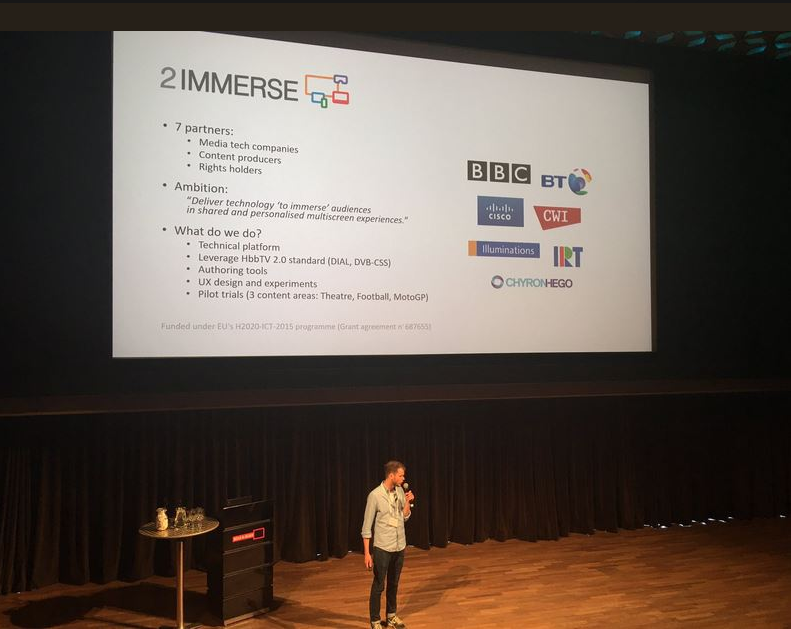‘Television and the Second Screen’
Although there is a developing academic and technical literature about specific aspects of second screen media production and engagement (to which we hope 2-IMMERSE is making a useful contribution), there are as yet few publications that attempt to step back and survey the field. Part of the problem in doing so, of course, is that the field, like so many other aspects of today’s media world is extraordinarily protean, seemingly changing from day to day. Moreover, the process of book publishing means that volumes risk being out of date even as they appear.

James Blake’s study Television and the Second Screen: Interactive TV in the Age of Social Participation, however, which was published by Routledge in November 2016, remains valuable for its history, thoughtful analysis and television industry insights. Before becoming an academic at Edinburgh Napier University, Blake worked for 20 years as a television reporter and producer, and his perspective is largely that of a broadcast professional, and he is primarily concerned with the ways in which social participation on mobile devices in changing the previously dominant forms of creation and consumption. Most of the examples are drawn from British television, although there are comparisons drawn with programmes from other European countries and from the USA. Blake is especially concerned with the debate about second screen activity as ‘distraction’ from television, and the consequences that this may have for traditional programme forms and funding structures. But he quotes Dan Biddle, Head of Broadcast Partnerships at Twitter UK in 2014:
It’s not split attention, it’s actually double attention. People are looking at everything at the same time, and we’ve got data that shows that people who are tweeting and watching TV are far more engaged with the messages that come out of those TV shows.
Overall, there’s much in his study, which is based on interviews with some 25 practitioners, that is fruitful for anyone working in or studying the convergence of second screens with conventional television. Each of the book’s chapters also has a bibliography referencing a wide range of sources, many of which are freely available online.
Blake begins with an interesting if rather too sketchy (at least about the 1950s and ’60s) chapter about the history of interactive television, before digging deeper into the industry’s construction of ‘active’ and ‘passive’ audiences. He considers the motivations that researchers have identified for why we watch television and the ways in which the broad categories clustering under the ‘uses and gratifications’ theory have shifted and developed. The third chapter considers the television forms where interactivity has been successful, including play-along interaction (the main case study is Channel 4’s Million Pound Drop), integrated audience activity (The X Factor) and transmedia storytelling (Big Brother). There is also a consideration of some of the problems and challenges that these forms have thrown up: the difficulties of broadcast delay, cheating and getting the balance right between first and second screen experiences.
Chapter 4 considers issues about second screen media and news programming, looking especially at the coverage of the 2015 General Election and the Scottish Referendum. While this is interesting much of it feels somewhat behind the curve given developments especially in the United States about Russian intervention via Twitter and Facebook. In the next chapter there is a very useful summary of a range of initiatives by the BBC and Channel 4 to develop second screen projects alongside factual programming, including for the Springwatch cluster of shows and Big Blue Live in 2015. Drama is the focus of Chapter 6, where Blake explores multi-platform transmedia storytelling for Coronation Street, Sherlock and a number of US series.
Perhaps of most relevance to 2-IMMERSE is the chapter that consider televised sports and the second screen, at the London Olympics 2012, for the rugby Six Nations and World Cup, and horse racing. As Blake observes, ‘The proliferation of mobile platforms and second screen apps has created opportunities to develop new categories of rights.’ But there are other important aspects of commercialisation as well, including betting and fantasy sports games. As for advertisers, Blake explores how ‘the second screen is both a golden opportunity and an escalating threat.’
What next? Or at least, what did the author think might be next 18 months back? One key question remains pertinent: ‘could the second screen go the way of 3D TV?’ Is there an enduring appeal to the experiences that have been, and will be, developed. Then there are the likely impacts of 360 video and VR. Add to which are questions about funding, regulation. But Blake is upbeat in his conclusion:
READ MORETV viewers now expect genuine two-way interaction. This is a genie that, once released, can’t easily be put back into its bottle. So whatever the future holds for television viewing, it will involve mobile and social engagement and be designed to encourage genuine viewer participation.
2-Immerse at half time
The 2-IMMERSE project has just past its halfway point, with another 17 months to run until the end of November 2018. So this seems like a good moment to take stock – and also to breathe life back into our blog, which needs to be much more active than it has been to date. Our intention now is to post at least once a week, on Mondays, and to contribute a wider range of reflections on our research and progress, and on related topics. You can also keep up to date on this via our Twitter feed @2Immerse.
The key outputs are our public deliverables, which can now be found here. Those papers that are probably of most interest beyond the project include (with links that take you to downloadable .pdf files):
D4.1 Prototype Service Descriptions – Initial Version
The four multi-screen service innovation prototypes that will be developed by 2-IMMERSE are described in this document. They are called “Watching Theatre at Home”; “Watching Theatre at School”, “MotoGP at Home” and “Watching Football in a Pub”. For each service innovation prototype the market context, the social context and the trial plans are described. Whilst the use cases are described very specifically, it seems clear that many aspects of service innovation concepts will have much broader applicability.
D3.1 General Concepts, Designs and Interactions for Multi Screen Experiences
This document outlines the concepts at play in the design of the multi-screen experiences under development in 2-IMMERSE for the project’s four pilots.
D2.1 System Architecture version 1
This document describes the system architecture being developed by the 2-IMMERSE project. This architecture is designed to enable the four multi-screen service prototypes that will be delivered through the project. The System Architecture is layered as a set of platform services, a client application architecture and production architecture. The system architecture is a work in progress; it will evolve both as we refine it and specify it in more detail, and as we deliver each of the multi-screen service prototypes through the project.
This document describes the first release of the 2-IMMERSE Distributed Media Application Platform, Multi-Screen Experience Components and Production Tools that have been developed for the project’s first service prototype, “Watching Theatre at Home”. It provides an illustrated tour of the project’s technical achievements to date, along with details of the current status of the platform and components and key features developed beyond those described in deliverables D2.1 and D2.2.
Earlier this year we organised our first trial with the Theatre at Home prototype, which was a fascinating experiment even if the results were mixed. We learned an enormous amount from the trial, and it tested in numerous ways the system architecture that the 2-IMMERSE team has spent many months building.
The prototype service allows two households to share the experience of watching a theatre performance together with the production being presented on a TV screen. Each household has a second screen device, a tablet, and can use this to access synchronized information streams and communication resources directly from the provider of the broadcast. The experience is curated to mirror aspects of the ritualised nature of going to the theatre. The experience thus allows users to:
- Chat to each other (using video chat) before and after the performance and during the interval
- Receive warnings, as they do when they visit the theatre, that the performance was about to start.
- Access additional material related to the production, much as they would in a theatre programme.
- Send messages to each other discretely during the performance using text chat.
A detailed exploration and evaluation of the Theatre at Home trial is now available in our deliverable D4.2 Theatre trial evaluation results (link to .pdf)
We are confident that our platform is now appropriately flexible and sufficiently robust to allow us to run our next set of trials for the MotoGP at Home prototype alongside the British Grand Prix event at Silverstone, 24-27 August 2017. More details of our work at Silverstone will be featured here.

One other welcome piece of news about the project is that 2-IMMERSE won Best Paper Award at the recent ACM TVX2017 conference and trade show at Hilversum in The Netherlands. The project successfully demonstrated our Theatre at Home prototype at TVX2017 – and the abstract for this presentation, 2-IMMERSE: A Platform for Orchestrated Multi-Screen Entertainment, is available here. And thrillingly, Best Paper Award was given to ‘On time or not on time: a user-study on delays in a synchronised companion-screen experience’, authored by IRT’s Christoph Ziegler (pictured above at TVX) and Christian Keimel and the BBC’s Rajiv Ramdhany and Vinoba Vinayagamoorthy. A sliver of the award citation is our header image above.
READ MORE

